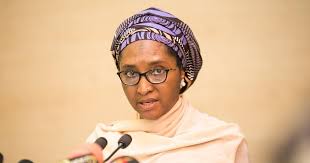Breakdown and Highlights of 2022 Budget Proposal

Friday, January 07, 2022 / 03:41 PM / by Office of the Honourable Minister of Finance, Budget & National Planning
Introduction & Background
Mr. President laid the FGN 2021 Budget Proposal on October 8, 2020. The National Assembly (NASS) passed the Bill by December 21, and Mr President signed it into law on December 31, 2020.
This underscores the Administration’s firm commitment to sustain the return to a predictable January – December fiscal year, as well enact annual finance acts to facilitate implementation of the budget.
A supplementary budget of N982.73bn was also passed by the NASS on the 7th of July, 2021, and Mr. President assented to it on the 26th of July, 2021 bringing the total appropriated expenditure for 2021 to N14.57 trillion.
The Nigerian economy lapsed into recession in Q3 2020, after two successive quarters of negative GDP growth, but promptly emerged from the recession with a positive 0.11% GDP growth in Q4 2020.
The economy sustained the recovery, with a Q1 Year-on-Year (YoY) GDP growth of 0.51% and a Q2 of 5.01%, fuelled by implementation of government’s Economic Sustainability Plan and helped by the easing of COVID19 induced restrictions on economic activities.
The growth was mainly driven by the non-oil sector, which rose by 6.74% YoY, masking the deterioration in oil GDP by -12.65% YoY.
Other non-oil performance include trade (22.5% YoY) water supply and waste management (18.5%), ICT (5.5%) and human and health services (4.9% YoY) growth rate
The persistent rise of inflation halted in April 2021 after nineteen consecutive months. From a four-year high of 18.17% in March 2021, the consumer price index (CPI) which measures inflation moderated for the fourth consecutive month to 17.01% in August 2021, with the downward trend expected to continue through the end of the year.
High unemployment/underemployment rates have implications for poverty incidence in the population. NBS’ Q4 2020 estimates put unemployment at 33% and underemployment rate at 22.84%.
Overview of 2021 Fiscal Outcomes & Update on 2021 Budget Implementation
Update On 2021 Budget Implementation (JAN – AUG)
Revenue Performance
The fiscal numbers are preliminary and will be updated as the reconciliation process is concluded.
As at August 2021, FGN’s retained revenue was N3.93 trillion, 73% of target:
• FGN share of oil revenues was N754.2 bllion (representing 56.3% performance of the prorated sum in the 2021 budget) while non-oil tax revenues totalled N1.15 trillion (115.7% over and above the target).
• Companies Income Tax (CIT) and Value Added Tax (VAT) collections were N547.54 billion and N235.77 billion, representing 121% and 148% respectively of the prorata targets for the period.
• Customs collections was N338.66 billion (99% of the target).
Other revenues amounted to N1.71 trillion, of which FGN Independent revenues was N691.36 billion while GOEs’ retained revenues was N873.52 billion.
Expenditure Performance
On the expenditure side, N8.14 trillion (or 84%) has been spent out of the N9.71 trillion prorata budget. This performance is inclusive of expenditure estimates of the GOEs but exclusive of Project-tied Loans.
Of the expenditure,
N2.87 trillion was for debt service, and
N2.57 trillion for Personnel cost, including Pensions.
As at August 2021, N1.759 trillion had been expended for capital. Of this, N1.723 trillion represents 81% of the provision for MDAs’ capital, and N36.01 billion as GOEs capital expenditure.
Updates on Global Outlook and Domestic Developments
Underlying Macroeconomic Assumptions, Parameters & Targets for the 2022 Budget
Projections
Consumption is projected to surge in the medium-term growing from a revised N136.57 trillion in 2021 to N149.35 trillion by 2022, about 9.36% increase. This growth momentum is projected to be sustained reaching N179.64 trillion in 2024.
Nominal GDP is projected to rise from N168.60 trillion in 2021 to N184.38 trillion in 2022 and then up to N221.78 trillion in 2024.
Real GDP growth forecast is 4.2% in 2022.
Inflation is expected to remain above single digit in the medium-term given structural issues impacting cost of doing business, including high food distribution cost. The steady decline is however expected to be sustained, seeing inflation rate drop to 13% in 2022 and 10 % by 2024.
Although Nigeria’s total production capacity is 2.5 mbpd, current (year to date) crude production is about 1.4mbpd (slightly short of the OPEC+ production quota), and an additional 300,000bpd of condensates, totaling about 1.6mbpd.
Oil production is projected to average 1.88 million barrels per day (including condensates) in 2022.
The Energy Information Administration (EIA) expects that global oil production will increase to match rising levels of global oil consumption.
OPEC crude production is projected to average 28.34 million barrels per day in 2022 higher than 26.94 million barrels per day forecast for 2021.
World Bank forecasts that crude oil prices will rise gradually from an average of US$60 pb in 2022 to $61 pb in 2023, and US$61.9 pb in 2024. EIA sees 2022 oil prices averaging $66.04 per barrel.
Justification for Oil Price and Production Assumptions
The realities of 2021 portend sustained OPEC Supply Cuts, ongoing vaccination, and rebounding Global GDP led by Emerging Economies.
In consultation with NNPC & other stakeholders, our base oil price scenario in the Medium Term is (2022: $57/bbl, 2023: $57/bbl, 2024: $55/bbl) and this is premised on the averages of leading forecasting institutions, factors affecting market fundamentals, global economic recovery, plans by governments and market sentiments.




